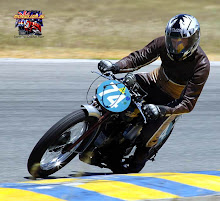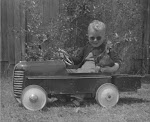A Red In The Shed (345)
Some Delays on the Road Back to the Track
The Li’l Speedy rebuild has been the classic one step forwards – two steps backwards affair. I was slow off the mark through the hot Perth summer, but during April things started to come together. The Carrillo conrod was machined to fit between the Velo flywheels, a couple of Triumph Daytona pistons (one standard 69mm Triumph bore, the other +.010 inch) arrived from NZ, the barrel was bored and the little end bush made to suit the non standard piston and rod combination. With Paul Barfoot’s help, the whole crank assembly was soon in one piece with a pair of ‘new old stock’ Hoffman roller bearings that I had been saving, fitted to both the drive and timing side mainshafts.
A couple of known issues remained. The timing side mainshaft was a little undersized, so that bearing was fitted to the shaft with a drop of Loctite. The timing side crankcase main bearing housing had stretched, so the outer cup was no longer a shrink fit. And the Carrillo rod was about 10mm shorter than the original Velo rod, so a fin or two would need to come off the top of the barrel to get back to around 11:1 compression ratio. And of course the pushrods would need to be shortened even further, with the possibility that the cutaways in the spigot of the barrel may need to be enlarged to accommodate the greater fore and aft rock of the shorter conrod.
Before trial assembly of the bottom end, I checked balance factor with the new piston and conrod and was pleased to discover that it was just over 75%, which is right in the recommended range for an iron MAC, so no adjustment needed.
That is where the good news ended. The trial assembly of the bottom end faltered when I found it impossible to get the drive side bearing into the shrunk fit outer. As I had not yet dealt with the timing side stretch issue, there was no problem fitting this side up. Frustrated I researched some articles I’d seen about bearing clearances. I recall that this had happened with a KSS special that Jack Hogan built, so suspected that the use of bearings with too tight a clearance may be the cause. This proved to be true as Veloce used C3 clearance for main bearings and the markings on these ‘new old stock’ bearing indicated the much tighter “C2”clearance. According to SKF, “C3” bearings of this size have 35 microns clearance, “Normal” bearings have 20 microns and “C2” bearings have only 10 microns. So it is clear why my Hoffman bearings would not fit together once installed with nipped outer and press fit inner.
Rather than attempt to increase running tolerance on these bearings by precision grinding (difficult with a single lipped design) or careful lapping, I decided to convert to readily available 2 inch imperial roller bearings, which would solve my timing side fit issue once the cases were machined. The new bearings will also require shimming, as they are about 3mm narrower than the originals, and a thin sleeve on each mainshaft to go from 22mm to 7/8 inch. This is a conversion used successfully by David Morse in his VMX Velos and more recently in his historic road racers so I’m happy enough to follow suit. By the way, the SKF bearing number is CFL7A/C3 and the cost is about $60 each.
A trip to the USA in July combining a little business with a large amount of Velo rally pleasure didn’t help to advance the Li’l Speedy project either. But it was worth it – see story elsewhere this issue.
With these obstacles now almost out of the way we plan to be back on the track for the final non-championship 2+4 meeting at Collie in early October then ready for the Nationals at Wanneroo Raceway in late November. It’ll be great to be out there again rather than watching from the pits.
– JJ
5 hours ago



No comments:
Post a Comment